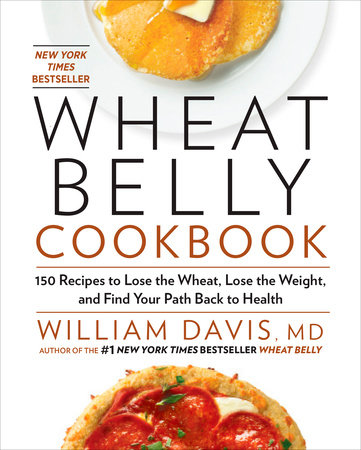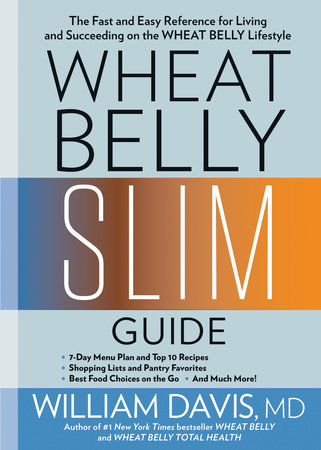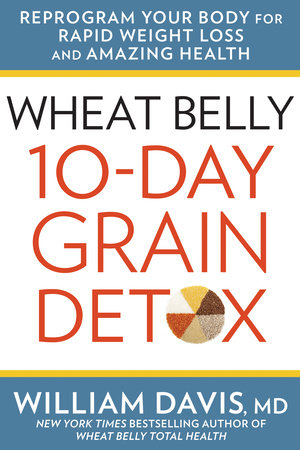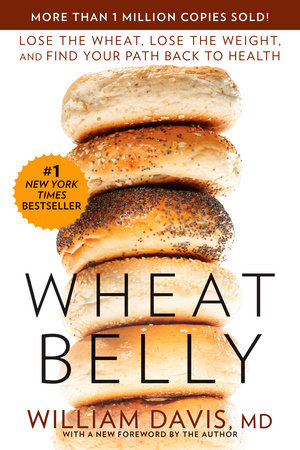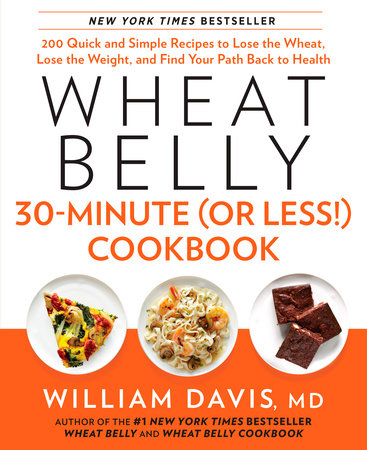Excerpt
Wheat Belly Cookbook
INTRODUCTION
Wheat is not the "healthy whole grain" it was pretending to be. Like a faithful spouse exposed as a philanderer and polygamist, wheat is not to be trusted. Held up as an icon of health, it is in reality a major contributor to the world's worst epidemic of obesity and an astounding list of health problems, from simple annoyances like dandruff to incapacitating conditions like dementia.
This is a cataclysmic revelation for most people: It's unsettling, it's upsetting, it's downright inconvenient. The condemnation of wheat is as paradigm shifting, earth shattering, and life changing as the emergence of the Internet, the packaging of collateralized debt obligations and the collapse of mortgage markets, the upheavals of the Arab Spring . . . events that shook core beliefs, upended comforting habits, and changed worldviews.
Wheat is the Enron of the food world, the tobacco industry all over again--frauds, both intentional and inadvertent, conducted on an international scale. Charming and engaging on the outside, sociopathic and destructive on the inside, it works its way into your life, wreaking havoc in every conceivable health-destroying way.
These are, for those of you unfamiliar with the arguments set forth in
Wheat Belly: Lose the Wheat, Lose the Weight, and Find Your Path Back to Health (Rodale, 2011), undoubtedly bold assertions that fly in the face of nutritional wisdom. The Dietary Guidelines for Americans issued by the USDA and the US Department of Health and Human Services, as well as the American Heart Association, the American Diabetes Association, and the Academy of Nutrition and Dietetics all agree: Healthy whole grains should make up a substantial portion of your diet.
This is colossally bad advice. "Eat more healthy whole grains" is among the biggest health blunders ever made in the history of nutritional advice. Modern health care, treating millions of people at the cost of hundreds of billions of dollars every year for hypertension, high cholesterol, obesity, arthritis, acid reflux, irritable bowel syndrome, fibromyalgia, migraine headaches, depression, diabetes, various forms of neurological impairment, and on and on, is really treating . . . wheat consumption. And the endlessly repeated advice to eat more "healthy whole grains" fuels this fire, much to the appreciative applause of the pharmaceutical industry. After all, the pharmaceutical industry funds a good part of the wheat lobby promoting and propagating this message. Oh, you didn't know that? Yes, a long list of drug manufacturers have close financial ties to the organizations that lobby Congress, help establish school lunch policy, and get cozy with the USDA to maintain the lofty nutritional role of "healthy whole grains."
And, yes, the clinical studies documenting these arguments have already been performed, but rarely do they make the light of day in media supported by Big Food, who count wheat products among the handful of commoditized ingredients, subsidized by the US government, that serve as the basis for most processed foods.
In health, as in software, we are living examples of the principle of garbage in, garbage out. Put this stuff, the creation of geneticists from the 1960s and 1970s, into your body, and you get all manner of unanticipated health effects.
Since the release of Wheat Belly, I have become convinced that not only is this an incredibly big issue for health, the situation is worse than it first appeared. It has affected far more people than I originally anticipated and to such an extraordinary degree that it is difficult to overestimate the severity of this problem. This is no fad that will flare and then burn out, much as the misguided low-fat notion has. This is not a dietary precept like "get more fiber." It is an exposure of the genetic and biochemical changes introduced into this common foodstuff, all in the name of increased yield-per-acre, but with no questions asked about its suitability for human consumption.
We are, in effect, experiencing the consequences of a grand agricultural experiment gone sour.
Hey, Marlboro Man: Have a Bagel!
Remember this? "According to a nationwide survey: More doctors smoke Camels than any other cigarette"? In the mid-and latter 20th century, the national discussion went from gushing about the pleasures and health benefits of smoking, to studies documenting the health damage caused by smoking, to executives denying any wrongdoing to Congress, to uncovering concealed documents demonstrating the industry's knowledge of the adverse health effects of smoking decades earlier.
We are reliving the tobacco experience with wheat in its place. I believe that smart food scientists stumbled on the appetite-stimulating effect of the gliadin protein in wheat 25 years ago. How else do we explain why wheat is in virtually all processed foods, from tomato soup to licorice? In 1960, you would have found wheat in bread, rolls, and cakes--obvious places that make sense. Go up and down the food aisles in your local supermarket in the 21st century, and you will find that nearly all canned, packaged, and frozen foods contain wheat in some form. Is wheat that necessary for taste, or for texture? I don't think so. I think it's put there for one reason: to stimulate your appetite and increase sales.
The transformation of the gliadin protein in newly created strains of wheat was accompanied by an increase in calorie consumption of 440 calories per day. By putting wheat in everything, the food industry, especially Big Food, ensured that you come back for more. Just as tobacco manufacturers increased nicotine content of cigarettes to ensure addiction, so adding wheat to every processed food created addictive behavior in response to all things wheat. Eating 440 more calories per day, 365 days per year--not only does that add up to a lot of calories and a lot more food consumed, it adds up to a lot more weight. (Using a simple calories-in calculation, this yields 160,000 calories, or 45.8 pounds gained in a year. This is an oversimplification, since calories-in, calories-out is a flawed concept, but it nonetheless illustrates how substantial this effect can be.) The introduction of the new form of gliadin was followed shortly thereafter by a nationwide increase in weight. After people gained 30, 50, 60, or more pounds, an explosive surge in diabetes followed. We are now in the midst of the worst epidemic of diabetes ever experienced by humans, such that the curve showing the number of people with diabetes is in a vertical climb straight upward, a trajectory that is likely to engulf your children and grandchildren.
The gliadin protein of wheat ensures that wheat products, such as whole grain or white breads, bagels, and muffins, are addictive: They generate a need for more . . . and more, and more. Gliadin is an opiate, you will discover, with its own form of euphoria and its very own opiate withdrawal syndrome when wheat consumption stops that can also be provoked with opiate-blocking drugs.
So the inadvertent transformation of wheat gliadin into a much more potent appetite stimulant, recognized quickly by observant food scientists, brought us here, to this overweight, diabetic situation that now plagues Americans and much of the rest of the developed world . . . while we are advised to eat more "healthy whole grains." No doubt, many people profited handsomely--and continue to do so--from this message, but the public has paid the price, both with their pocketbooks and their health.
There's Power in Them Tweets
Since the release of the first Wheat Belly, social media has served the role of a worldwide stage for these arguments to play out.
Some things, when enacted in real life in real people, are so consistent and powerful that, despite their anecdotal nature, they serve to reinforce what we learn through scientific observation. If I hit my head with a hammer and it hurts, and my head stops hurting when I stop hitting it, do I need a double-blind, randomized clinical trial to prove that hitting my head with a hammer causes head pain? The association is so consistent and obvious that you can safely accept the premise that the hammer is the cause. Likewise, eliminating wheat has been demonstrated, through the thousands of people who have embraced these ideas, to produce life-changing transformations of health and weight that most thought were impossible, allowing them to throw away multiple medications and leave behind years of pain, wheezing, diarrhea, cramps, swelling, fatigue--within days of saying goodbye to their bran muffins or breakfast cereal.
In the Middle East, social media allowed the masses to organize, communicate, and overthrow despotic dictators. In no other time in history could dissent disseminate so rapidly, revolt be organized within hours. Likewise, social media is now showing us, on an unprecedented scale and abbreviated timeline, that rejecting all things wheat is among the most powerful and liberating health strategies imaginable. We purge this Muammar Gaddafi of diet using the facility and speed of Twitter, Facebook, and other electronic media, spreading the word of dietary revolution using the very same tools.
This is not a popular message at the USDA, or in the halls of Big Food and Big Agribusiness. It's not uncommon, for instance, for agribusiness giant Monsanto to spend more than $2 billion per quarter to lobby the federal government to influence policymakers--and that's just one company. Dollar for dollar, we cannot even begin to compete with such forces. Ah, but we can talk to each other and share our experiences, something that these dominating corporate forces are unlikely to do with us.
Lose the Wheat, Lose the Weight . . . and the Acid Reflux, and the Edema, and the Mental "Fog" . . .
Much like when you stop hitting your head with a hammer and the headache miraculously goes away, so eliminating all wheat from the diet is followed by the majority of people experiencing abrupt and substantial weight loss along with relief from a long list of health conditions.
In other words, the proof of this concept is in your own hands, a simple rearrangement of food priorities in your own pantry. You don't have to wait for a large-scale clinical trial to know whether this is relevant to your health situation. If you decide to wait for national advice to embrace this concept, you are going to wait a very, very long time. How do official agencies undo the disastrous advice of the last 40 years without losing credibility, without incurring legal liability for the unimaginable economic damages--and without losing the revenue stream that this corrupt message has generated? You don't have to wait. You can start the process and know within days whether this thing called wheat has been to blame for your health and weight.
The total effect experienced in eliminating wheat is greater than the sum of its parts: It's a 2 + 2 = 11 phenomenon. That's no typo. Getting rid of wheat is that big. Despite our knowing about many of the undesirable changes introduced by geneticists into modern wheat, the health changes--health transformations--experienced by most people who say goodbye to wheat are often far greater than we'd predict. It makes for some of the most compelling success stories in weight and health you could imagine.
Gluten-Free . . . and Other Blunders
A growing number of people are declaring themselves gluten free, thereby buying and consuming gluten-free foods.
Big mistake. Yes, it's a very good thing to avoid the gluten from wheat. But this can take you down the path of gluten-free processed foods. Oddly, the majority of manufacturers of gluten-free foods have chosen to base their products--with rare exceptions--on rice starch, cornstarch, potato starch, and tapioca starch. While they may provide a reasonable facsimile of gluten-containing wheat flour-based products in taste and texture, they are among the few foods that raise blood sugar even higher than the high levels generated by wheat products. In other words, gluten-free multigrain bread or gluten-free pasta, from the perspective of high levels of blood sugar and its consequences, are poor choices as replacements for wheat.
So we should be wheat free and gluten free, but also free of gluten-free foods made with junk carbohydrates.
A bit confusing, yes. This was part of my motivation for adding the Wheat Belly Cookbook to the discussion, to help you recreate delicious foods without wheat and without the rice starch, cornstarch, potato starch, and tapioca starch of commercial gluten-free foods. The recipes presented herein are tasty, don't screw with blood sugar, don't trigger appetite, and are truly healthy--a novel concept!
Lettuce and Cardboard?
For many people, the prospect of giving up wheat is daunting, even downright terrifying, especially since wheat comes with its very own withdrawal syndrome. Not only might you be deprived of something that yields an addictive relationship, but what foods will remain? Will you starve? Will you have to live on lettuce, cardboard, and tasteless replacement foods?
Not at all. As many wheat-free people will attest, foods minus wheat are actually more enjoyable. A fundamental change occurs when you remove this addictive food: You enjoy food for its own sake, not because there is an appetite stimulant present making you eat anything you can get your hands on. Taste is heightened: You are better able to discern the nuances of foods, but also more sensitive to sweetness, with formerly tasty treats now sickeningly sweet. You are less hungry to the tune of 440 fewer calories per day; what you eat, you enjoy more since you are having less.
Foods can be wonderfully varied without wheat. In addition to beef burgundy and pizza, you can have muffins, cookies, pies, scones, and other former wheat-containing foods, made using truly healthy ingredients. These are among the 150 recipes in the Wheat Belly Cookbook.
What this is not is a gluten-free cookbook. No food manufacturer or author of a gluten-free cookbook I know of yet understands the principles of healthy wheat-free, gluten-free eating sufficiently to craft truly healthy gluten-free food. If you want to get fat and diabetic, develop cataracts and arthritis, and grow a belly full of inflammatory visceral fat, eat gluten-free substitutes sold in stores or follow the recipes in the newest gluten-free cookbook. So the recipes I've developed here are indeed free of wheat and gluten, limited in carbohydrate exposure--and truly healthy.
Quit Your Bellyaching!
"Don't you miss it?" and "Aren't you tempted to eat a doughnut?" are among the common questions from those contemplating a life sans wheat.
If, by the end of these opening chapters, you aren't eyeing your beloved multi-grain bread or onion ciabatta with suspicion or outright horror, then I haven't done my job. I see my role as exposing these arguments to the light of day for all to see, not just the tarted-up, hunky-dory version presented to us by those who profit from influencing the message. My hope is that, by the time you have finished reading the first few chapters, you will understand that not only is this creation of genetics research awful for weight and health, it is downright deadly. Removing it is . . . liberating. It's the rainbow after the storm, remission after cancer treatment, viewing bright colors after a lifetime of blindness.
Be sure to read the success stories that I've peppered throughout the recipe section detailing many of the compelling tales of health and weight turnarounds that have come my way ever since this message has gained an international audience. Read real stories of dramatic weight loss, relief from crippling health conditions, transformations of children's behaviors—all from people denying themselves the effects of this creation of modern genetics research called wheat.
“Fried” Parmesan-Crusted ChickenKid-Friendly
Prep Time: 10 minutes
Total Time: 45 minutes
Makes 4 servings
Who doesn’t love fried chicken? This “fried” chicken is easy to whip up in minutes and will serve you well with the kids.
Make the “breading” as bland or spicy as you or your family desires by reducing or loading up on the oregano and paprika. For added spiciness, add some hot-pepper sauce to the egg mixture or ground red pepper or chipotle pepper to the dry “bread” crumb mixture.
It’s best to reheat any leftovers in the oven or toaster oven, rather than the microwave, because the “breading” has a tendency to get soggy when stored.
2 eggs
2 tablespoons extra-virgin olive oil
1 cup ground flaxseeds
1/2 cup grated Parmesan cheese
1 teaspoon onion powder
1 teaspoon dried oregano
1/4 teaspoon paprika
1/2 teaspoon sea salt
2 pounds chicken drumsticks
1. Preheat the oven to 375°F. Coat a large baking pan with cooking spray.
2. In a shallow bowl, whisk the eggs and oil until blended.
3. In another shallow bowl, combine the flaxseeds, Parmesan, onion powder, oregano, paprika, and salt and mix thoroughly.
4. Dip each drumstick into the egg mixture to coat and then roll in the flax mixture, shaking or tapping off any excess. Place in the baking pan, leaving space between each drumstick.
5. Bake for 35 minutes, or until a thermometer inserted in the thickest portion registers 170°F and the juices run clear.
Per serving: 516 calories, 43 g protein, 10 g carbohydrates, 35 g total fat, 7 g saturated fat, 9 g fiber, 610 mg sodium


